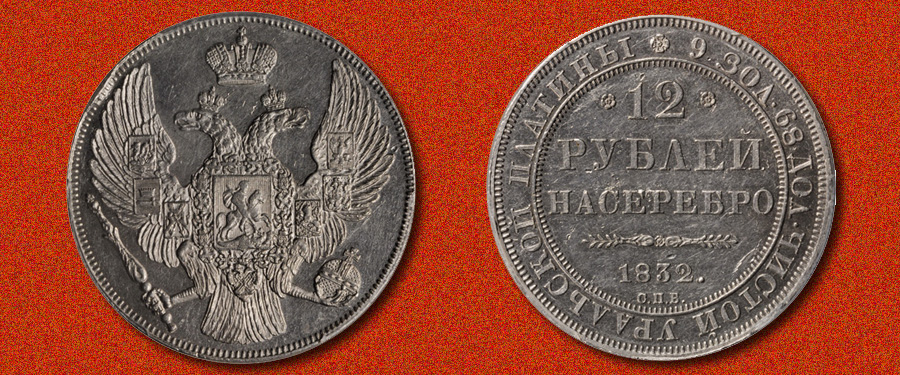
The Stack’s Bowers Galleries August ANA World’s Fair of Money auction in Chicago is less than two weeks away. We take great pride in the impressive section dedicated to Russian numismatics. In this article we focus on the earliest platinum coinage issued by Imperial Russia. The name platinum is a derivative of the Spanish word platina, which means “little silver” and at first glance the two are visually similar, which would be a factor in platinum’s eventual failure as a circulation coinage in Russia. Russia remains the only country to have struck platinum coins for circulation.
The discovery of platinum in the Urals of Western Siberia resulted in the production of three new Russian decimal coinage denominations. By the imperial decree of April 24, 1828, platinum coinage was initiated for circulation. The initial minting was only of the 3 Ruble denomination; a later decree authorized the production of 6 and 12 Rubles (the platinum 12 Ruble was authorized on September 12, 1830). The planchet size for this platinum issue was consistent in diameter with the silver Ruble. The minting of platinum coinage in 19th century Russia was done on a very limited basis and for less than two decades. The new coinage denominations were not well received by the public, as the pale white metal was unfamiliar in circulation. In 1845, an imperial decree was issued ordering the minting of platinum coinage to cease. Simultaneously, the existing pieces were ordered to be recalled within a six month period. For this reason, much of the original mintages were redeemed and destroyed, which accounts for their rarity today. The six-month period for redemption was too short to be completely effective and is largely responsible for the examples known today.
The obverse design for this platinum 12 Ruble features a large motif of the Imperial Coat of Arms: the Imperial double headed eagle, each head crowned with a third crown and banner above. The left claw holds a scepter, representing monarchial power, and the globus cruciger in the right claw demonstrates the religious authority of the emperor. The Order of Saint Andrew, the highest honorary order in Imperial Russia, appears around the arms of Moscow showing Saint George mounted and defeating the dragon. A total of six provinces constitute the Russian Empire, and their Coats of Arms are displayed on the eagle’s wings: (From left to right) Kazan, Astrakhan, Siberia, Finland, Tauric Chersonesus, and Poland. The reverse depicts all of the pertinent information required for circulating coinage, with the outer layer designating: “9 parts Gold, 68 parts pure Urals platinum.” This phrasing was used to allow for the inclusion of the other noble metals iridium and palladium. The central inscription states: “12 Rubles per Silver” this wording was used to link this platinum series to the familiar silver ruble. Just below this inscription appear the date of 1832 and the St. Petersburg mintmark. The platinum 12 Ruble for the year 1832 has a reported mintage of only 1,102 pieces. This example is bright and very attractive and exhibits semi-prooflike fields. The strike is sharp with well-rendered details in central design, denticles and legends. Currently it is the finest certified of this date by PCGS.
Look for this and other world and ancient numismatic rarities in our upcoming August ANA World’s Fair of Money Auction and Sale. Preview this impressive coin along with the rest of our auction this July at the Stack’s Bowers and Ponterio office located in Irvine, California. For details please refer to the Events Calendar at www.StacksBowers.com. To schedule an appointment, please call 800.458.4646. While our Stack’s Bowers Galleries August ANA World’s Fair of Money Auction is closed for further consignments, we are currently taking consignments of ancient and world coins for our November 2014 Official Auction of the Whitman Coin & Collectibles Baltimore Expo and our January 2015 New York International auctions Time is running short, so if you are interested in consigning your coins and paper currency (whether a whole collection or a single rarity) be sure to contact one of our consignment directors.





